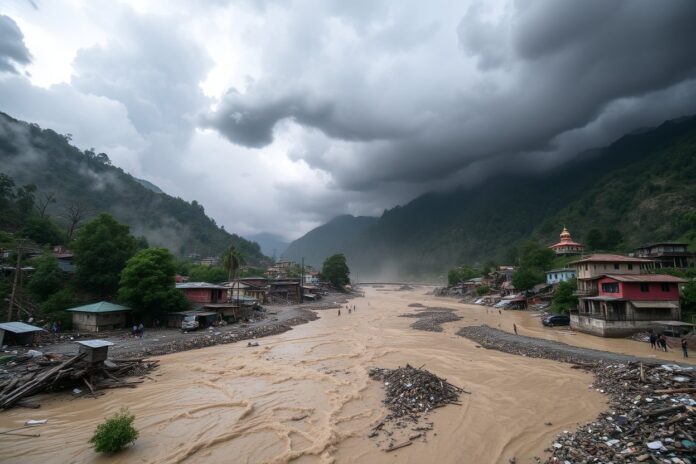On 5 August 2025, a violent cloudburst in the high‑altitude catchment of the Kheer Ganga river triggered a catastrophic flash flood and landslide, devastating Dharali village in the Uttarkashi district of Uttarakhand.
The Disaster Unfolds
At approximately 1:45 PM, a massive surge of water, mud, and debris cascaded down the hillside, sweeping through Dharali—just 4 km from the Army camp at Harshil. Locals recall scenes of sheer panic as 5–10 meter “waves” obliterated homes, hotels, and shops. Eyewitness Subhash Chandra Semwal said he had “never seen such a horrific scene in his life,” describing people running and screaming as structures collapsed around them.
Reports indicate that 4 people lost their lives, including civilians and possibly soldiers, while dozens are feared buried or missing—some estimates suggest as many as 50 to 100 people unaccounted for. Up to 20–25 hotels and guesthouses were swept away, and an estimated 40–50 homes destroyed.
A second cloudburst in the Sukhi Top area worsened the situation soon after the initial event.
Rescue and Relief Efforts
Rescue operations commenced within minutes, led by the Indian Army’s Ibex Brigade, aided by the NDRF, SDRF, ITBP, and local administration. Three NDRF teams (each of ~35 personnel), two more on standby, and cadaver dog units were mobilised from Delhi. A 16‑member ITBP team from Matli was also deployed.
Government Response & Alerts
Chief Minister Pushkar Singh Dhami described the destruction as “extremely sad and distressing,” declaring rescue operations are underway on a “war footing.” He held urgent meetings with state officials and briefed Prime Minister Narendra Modi.
The Indian Meteorological Department (IMD) has issued a red alert for heavy rainfall through August 9–10 across Uttarakhand. Schools and colleges in multiple districts have been ordered closed as a precaution.
Meanwhile, the Indian Air Force has kept Chinook and Cheetah helicopters on standby to assist relief teams.
Why Uttarkashi Remains Vulnerable
Experts warn that Uttarakhand’s fragile mountain ecology, combined with climate change, accelerated glacial runoff, and unregulated development, have made the region increasingly disaster-prone. Similar tragedies—including the 2013 Kedarnath deluge and the 2021 Rishiganga incident—underscore the urgent need for sustainable planning and robust preparedness.
Curiously, rainfall data from local stations indicated only light to moderate precipitation, not meeting the typical threshold of a cloudburst. Officials are investigating other possible triggers, such as glacial lake outbursts or sudden upstream water releases.
Immediate Impacts & Concerns
Pilgrimage route to Gangotri disrupted as Dharali serves as a key transit stop.
Over 163 roads blocked, including national and state highways, hampering rescue access.
Livestock losses reported, e.g., 18 goats swept away in nearby Barkot region.
Continued rainfall risks additional floods or landslides among already destabilised slopes.
Way Forward: Rebuilding and Resilience
Authorities must focus on:
Accelerated search for missing persons, including deployment of forensic dog squads.
Rapid relief distribution and temporary shelter for displaced residents and tourists.
Long‑term measures: enforce land‑use regulations, strengthen early‑warning systems, and promote climate‑sensitive infrastructure planning.
[Newsroom staff written original, where key claims or facts are used, I’ve referenced the original sources (like NDTV, The Indian Express, Hindustan Times, etc.) transparently.]




